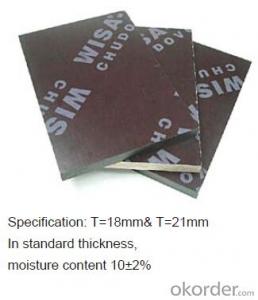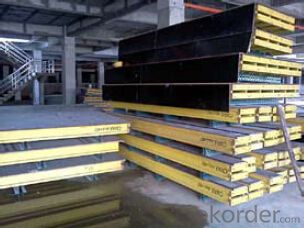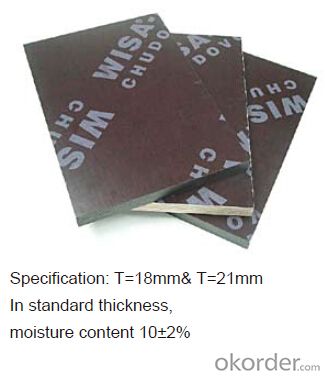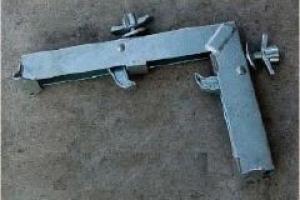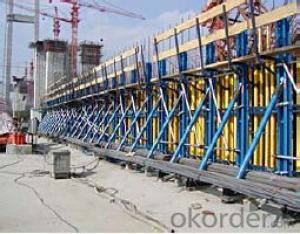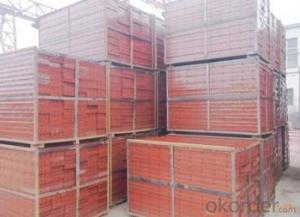Plywood Formwork Systems for Formwork and Scaffolding
- Loading Port:
- Tianjin
- Payment Terms:
- TT OR LC
- Min Order Qty:
- 50 m²
- Supply Capability:
- 1000 m²/month
OKorder Service Pledge
Quality Product, Order Online Tracking, Timely Delivery
OKorder Financial Service
Credit Rating, Credit Services, Credit Purchasing
You Might Also Like
Plywood --- make perfect concrete surface
WISA-Form Birch is a coated special plywood using in the formwork systems where high
requirements are set on the concrete surface and the times of reuses.
With CNBM timber beam & WISA plywood, the formwork is low weight but high load capacity, it is
widely used in construction.
Characteristics:
◆ Component with high standardization.
◆ Assembling in site, flexible application.
◆ Light weight, easy transportation and storage.

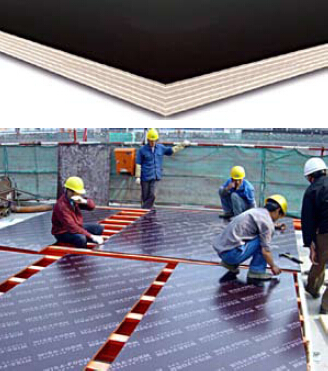
- Q: What are the different safety guidelines for dismantling steel formwork?
- When dismantling steel formwork, it is important to follow certain safety guidelines to ensure the well-being of workers and prevent accidents. Some of the key safety guidelines include: 1. Adequate training: Workers involved in dismantling steel formwork should be properly trained in the safe dismantling procedures. They should be familiar with the equipment and tools used and understand the potential hazards associated with the task. 2. Personal protective equipment (PPE): All workers must wear appropriate PPE, including hard hats, safety glasses, gloves, and steel-toed boots, to protect themselves from falling objects, sharp edges, and other potential hazards. 3. Secure the area: Before starting the dismantling process, the work area should be properly secured and cordoned off to prevent unauthorized access. Warning signs and barriers should be placed to alert others about the ongoing work. 4. Inspection of equipment: The steel formwork and associated equipment should be inspected for any damage or defects before dismantling. Any faulty equipment should be repaired or replaced to ensure safe dismantling. 5. Proper tools and equipment: Use the correct tools and equipment for dismantling, such as wrenches, hammers, and cutting tools. Ensure that they are in good working condition and used correctly to avoid accidents. 6. Controlled dismantling: Dismantle the steel formwork in a controlled manner, starting from the top and working downwards. Avoid sudden movements or actions that may cause parts to fall or collapse. 7. Fall protection: Implement appropriate fall protection measures, such as safety harnesses and lanyards, when working at heights. Install guardrails or safety nets to minimize the risk of falls. 8. Communication and coordination: Maintain clear communication among workers involved in the dismantling process to ensure everyone is aware of the ongoing activities and potential hazards. Coordinate the work to avoid any conflicts or accidents. 9. Safe handling and disposal: When removing steel formwork components, ensure proper lifting techniques are used to avoid strains or injuries. Dispose of dismantled materials safely and responsibly, following local regulations. 10. Regular inspections: Regularly inspect the dismantled formwork components, storage areas, and tools to identify any potential safety hazards and address them promptly. It is crucial to prioritize safety during the dismantling process of steel formwork to prevent injuries, accidents, and damage to property.
- Q: Can steel formwork be used for precast concrete facades with intricate patterns?
- Absolutely! Precast concrete facades with intricate patterns can indeed utilize steel formwork. Renowned for its robustness and longevity, steel formwork proves ideal for fashioning elaborate and meticulous designs. The adaptability of steel enables the crafting of intricate patterns, textures, and contours on the concrete surface. Moreover, steel formwork can be effortlessly tweaked and altered to accommodate any desired pattern or design, rendering it a favored option for precast concrete facades that demand intricate patterns or artistic elements. Ultimately, steel formwork offers the vital support and flexibility necessary to accomplish intricate designs in precast concrete facades.
- Q: What are the common safety guidelines when working with steel formwork in hazardous areas?
- When working with steel formwork in hazardous areas, it is important to follow some common safety guidelines. These include wearing appropriate personal protective equipment (PPE) such as safety goggles, gloves, and steel-toed boots to protect against potential hazards. Additionally, workers should ensure that the steel formwork is properly installed and secured to prevent any accidents or collapses. It is also essential to be aware of the weight and load capacity of the formwork to avoid overloading and potential structural failures. Regular inspections and maintenance of the formwork are necessary to identify any defects or weaknesses that could compromise safety. Lastly, workers should be trained on emergency procedures and know the location of emergency exits and evacuation routes in case of any unforeseen incidents.
- Q: How does steel formwork contribute to the overall structural stability of the building?
- Steel formwork is a crucial element in the construction industry and plays a significant role in ensuring the overall structural stability of a building. It contributes to the stability of the structure in several ways. Firstly, steel formwork provides a rigid framework for pouring concrete, which allows for the accurate shaping and alignment of structural elements such as columns, beams, slabs, and walls. This precision and control in the forming process ensure that the concrete cures in the desired shape, thereby creating a strong and stable structure. Furthermore, steel formwork offers excellent strength and durability. It can withstand high loads and pressures during the pouring and compacting of concrete, ensuring that the structure remains intact and structurally sound. Steel formwork is known for its ability to resist deformation and maintain its shape, preventing any potential structural failures. Another significant advantage of steel formwork is its ability to provide support to the concrete during the curing process. As the concrete hardens, it undergoes a chemical reaction known as hydration, which creates heat. Steel formwork effectively dissipates this heat, allowing the concrete to cure uniformly and reducing the risk of thermal cracking. By preventing cracks in the structure, steel formwork enhances the overall stability and longevity of the building. Moreover, steel formwork is highly versatile and can be easily modified and reused for multiple construction projects. This adaptability allows for efficient and cost-effective construction processes, as the same formwork can be used for different structural elements. This not only saves time and resources but also ensures consistency in the quality and stability of the building. In summary, steel formwork is essential for the overall structural stability of a building. Its accurate shaping, strength, support during curing, and versatility contribute to creating a robust and durable structure. With its ability to withstand high loads and maintain shape, steel formwork plays a vital role in ensuring the safety and stability of buildings in the construction industry.
- Q: Can steel formwork be used for architectural concrete slabs?
- Architectural concrete slabs can indeed utilize steel formwork. When compared to other formwork materials, steel formwork boasts numerous advantages in terms of its strength, durability, and versatility. By providing a rigid structure, it can effectively withstand the pressure exerted by fresh concrete, thereby guaranteeing accurate and precise placement of the slabs. Moreover, steel formwork can be conveniently reused multiple times, rendering it both cost-effective and environmentally friendly. Its smooth surface further contributes to the attainment of high-quality finishes for architectural concrete slabs. Nevertheless, it remains crucial to ensure proper insulation and the use of release agents to prevent heat transfer and potential concrete adherence issues caused by the steel. All in all, steel formwork proves to be a dependable and efficient choice for the creation of architectural concrete slabs.
- Q: What are the different types of connections used in steel formwork construction?
- Steel formwork construction utilizes various types of connections, each serving a specific purpose. 1. Bolted connections, the most commonly used type, involve securing steel formwork components together using bolts, nuts, and washers. This connection provides a strong and rigid joint that is easy to assemble and disassemble. 2. Welded connections fuse steel formwork components together using heat and pressure. They are ideal for permanent structures or situations requiring high strength and rigidity. However, welded connections are time-consuming and require skilled labor. 3. Clamped connections utilize clamps or brackets to hold steel formwork components together. This connection type is suitable for temporary structures or frequent disassembly/reassembly, as it is quick to assemble and disassemble and does not require specialized skills or equipment. 4. Interlocking connections employ specially designed mechanisms, such as tabs, slots, or grooves, to connect steel formwork components. These connections are commonly used in modular formwork systems, where fast and easy assembly is necessary. 5. Adhesive connections involve bonding steel formwork components together using epoxy or other adhesive materials. This connection type provides a seamless and smooth joint, often used for architectural or decorative purposes. Proper surface preparation and curing time are essential for achieving maximum strength. In summary, the choice of connection type in steel formwork construction depends on factors such as desired strength and rigidity, structure type, reusability, and available resources and expertise. It is crucial to select the appropriate connection type to ensure the safety and stability of the formwork system.
- Q: How does steel formwork handle surface imperfections in concrete?
- Construction projects commonly utilize steel formwork to create temporary molds for pouring concrete. One of the benefits of steel formwork is its effective handling of surface imperfections in concrete. The precise and controlled placement of concrete is facilitated by the smooth and rigid nature of steel formwork, which minimizes the occurrence of surface imperfections. Unlike wood or plywood, steel formwork does not flex or warp, ensuring consistent surface finishes. When surface imperfections do arise, steel formwork provides a solid foundation to address these issues. The strength and durability of steel enable it to withstand the pressure exerted by the concrete, preventing bulges or deformations that could result in surface imperfections. Moreover, steel formwork can easily be adjusted or modified to accommodate any irregularities or unevenness in the concrete. This flexibility allows for the correction of minor imperfections during the pouring process, resulting in a smoother and more even surface finish. Furthermore, steel formwork can be treated or coated to prevent sticking or bonding between the concrete and the formwork. This coating reduces the likelihood of surface imperfections caused by the concrete adhering to the formwork. In conclusion, steel formwork is a dependable and efficient solution for dealing with surface imperfections in concrete. Its strength, rigidity, and versatility enable construction professionals to achieve high-quality finishes, even in challenging conditions.
- Q: How does steel formwork affect the overall carbon footprint of the project?
- Steel formwork can significantly reduce the overall carbon footprint of a project due to its durability and reusability. As compared to traditional timber formwork, steel formwork can be used multiple times, thereby reducing the need for frequent replacements and lowering the amount of waste generated. Additionally, steel production emits less carbon dioxide than timber production, making steel formwork a more sustainable choice.
- Q: What are the considerations when designing steel formwork for bridges?
- When designing steel formwork for bridges, there are several considerations to take into account. Firstly, the load capacity of the formwork must be determined, ensuring that it can support the weight of the wet concrete and any construction equipment. Additionally, the formwork should be designed to withstand the forces generated during the pouring and curing of the concrete, such as lateral pressure and vibration. The formwork system should also be easy to assemble, disassemble, and adjust to accommodate different bridge geometries and dimensions. It is important to consider the durability and corrosion resistance of the steel used in the formwork, as bridges are often exposed to harsh environmental conditions. Finally, the design should incorporate safety measures, such as guardrails and access platforms, to ensure the safety of workers during construction.
- Q: What are the different types of steel formwork joint solutions?
- There are several types of steel formwork joint solutions, including lap joints, butt joints, corner joints, and T-joints. These solutions are used in construction to ensure the stability and integrity of the formwork system during concrete pouring.
Send your message to us
Plywood Formwork Systems for Formwork and Scaffolding
- Loading Port:
- Tianjin
- Payment Terms:
- TT OR LC
- Min Order Qty:
- 50 m²
- Supply Capability:
- 1000 m²/month
OKorder Service Pledge
Quality Product, Order Online Tracking, Timely Delivery
OKorder Financial Service
Credit Rating, Credit Services, Credit Purchasing
Similar products
Hot products
Hot Searches
Related keywords

